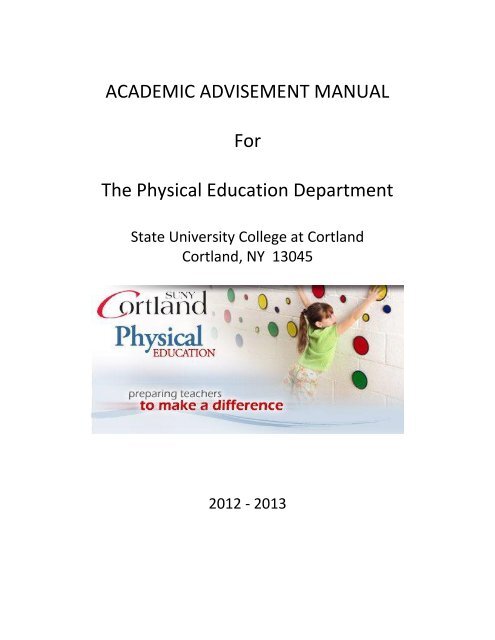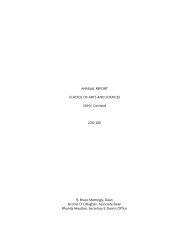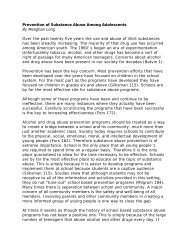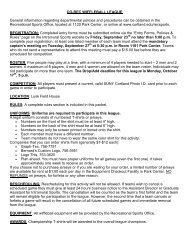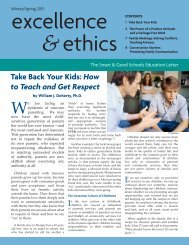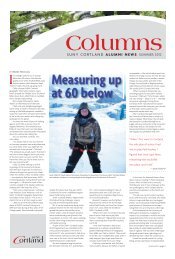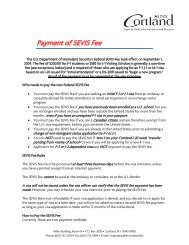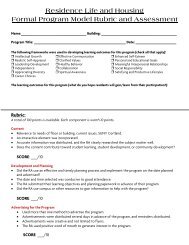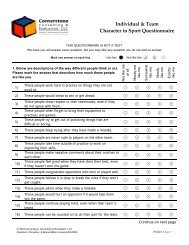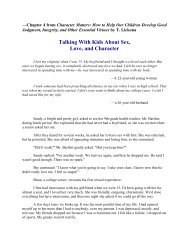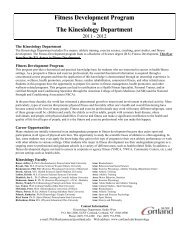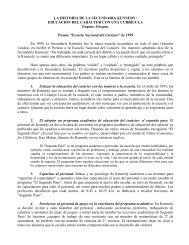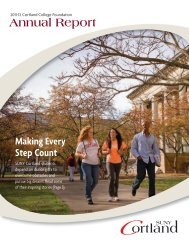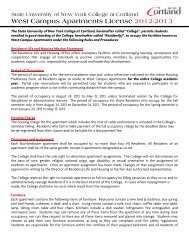ACADEMIC ADVISEMENT MANUAL - SUNY Cortland
ACADEMIC ADVISEMENT MANUAL - SUNY Cortland
ACADEMIC ADVISEMENT MANUAL - SUNY Cortland
- No tags were found...
You also want an ePaper? Increase the reach of your titles
YUMPU automatically turns print PDFs into web optimized ePapers that Google loves.
<strong>ACADEMIC</strong> <strong>ADVISEMENT</strong> <strong>MANUAL</strong>ForThe Physical Education DepartmentState University College at <strong>Cortland</strong><strong>Cortland</strong>, NY 130452012 - 2013
TABLE OF CONTENTSI. THE PHYSICAL EDUCATION PROGRAM AT CORTLANDa. Welcome to the Physical Education Department ........................................................................... 1b. The Physical Education Program at <strong>Cortland</strong> .................................................................................. 1c. Advising ............................................................................................................................................ 3d. The Physical Education Program Summary ..................................................................................... 3e. Program Philosophy ......................................................................................................................... 4f. Program Purposes ............................................................................................................................ 4g. Program Objectives ......................................................................................................................... 4h. Our Heritage .................................................................................................................................... 5i. Our Traditions .................................................................................................................................. 5j. Professional Organizations and Affiliations ..................................................................................... 6II. ALL COLLEGE POLICIESa. Student Disability Services ............................................................................................................... 7b. Class Attendance Policy ................................................................................................................... 7c. Retaking of Courses ......................................................................................................................... 8d. Repeated Courses and Financial Aid Eligibility ................................................................................ 8e. Transferring in Credit After Being Accepted to <strong>Cortland</strong> ................................................................ 8f. Summary of Requirements for Graduation ..................................................................................... 9g. Pass/No Credit Option ..................................................................................................................... 9h. Examination Policy ........................................................................................................................... 9i. Missed and Final Examinations ....................................................................................................... 9j. Academic Grievance System .......................................................................................................... 10k. The Academic Grievance Procedures ............................................................................................ 10l. Academic Dishonesty ..................................................................................................................... 11m. Procedures for Handling Academic Dishonesty ............................................................................ 11n. Computing Grade Point Average (GPA) ......................................................................................... 13o. Course Numbering System ............................................................................................................ 14p. General Information About Course Offerings ............................................................................... 14q. Composition Requirements ........................................................................................................... 14r. Writing Requirements ................................................................................................................... 14s. General Education Program .......................................................................................................... 15t. Transfer Courses ............................................................................................................................ 15u. Math Skills Requirement ............................................................................................................... 15v. History Requirement ..................................................................................................................... 15w. Forms ............................................................................................................................................ 16III. DEPARTMENT OF PHYSICAL EDUCATIONa. Program Requirements for Teacher Candidates ........................................................................... 16b. Notes for all Teacher Candidates................................................................................................... 18c. Elective Offerings in Physical Education ........................................................................................ 18d. Teacher Preparation Methodology Sequence ............................................................................... 20e. Special Notes for Transfer Students .............................................................................................. 21f. Recommendation Course Sequence for Transfer Students .......................................................... 22
g. Physical Education Department Professional Expectations .......................................................... 23h. Communication ............................................................................................................................. 23i. Dress code Policy ........................................................................................................................... 23j. Field Experience ............................................................................................................................. 24k. Technology Policy .......................................................................................................................... 24l. A Few Words of Caution ................................................................................................................ 25m. Accommodation Policy .................................................................................................................. 25n. Accommodation Form ................................................................................................................... 27o. Participation Credit ........................................................................................................................ 28p. Progress within the Major: GPA .................................................................................................... 28q. Progress within the Major: Grades in Block Sequence Courses .................................................... 28r. Books .............................................................................................................................................. 28s. Professional Portfolio .................................................................................................................... 28t. Student Teaching Requirements ................................................................................................... 29u. Teacher Education Candidacy ........................................................................................................ 29v. New York Teacher Certification ..................................................................................................... 30w. Options for Physical Education Teacher Candidates ..................................................................... 33x. Study Abroad ................................................................................................................................. 33y. Minors and Concentrations ........................................................................................................... 33z. Concentration Requirements for Adapted PE ............................................................................... 33aa. Emphasis in Adapted Physical Education ...................................................................................... 34bb. Dual Majors .................................................................................................................................... 34cc. Master’s in Health Education (4+1) ............................................................................................... 35dd. Department Awards ...................................................................................................................... 36IV. APPENDICESa. Advisement Planning Worksheet .................................................................................................. 37b. Activity Program Check List ........................................................................................................... 38c. Certification/Graduation Checks ................................................................................................... 39d. Disposition Rubric .......................................................................................................................... 40
Welcome to the Physical Education DepartmentWelcome to the Physical Education Department at <strong>SUNY</strong> <strong>Cortland</strong>! We are pleased that you havechosen a physical education major and anticipate that you will find our programs interesting,challenging, and exciting. We have a long tradition of producing successful teachers and leaders inthe field. We expect that you will uphold this reputation as you pursue your studies and join theprofession as one of our graduates.Our program is rigorous. You will be engaged in a broad-based education in the liberal arts andsciences as part of your General Education Requirements. Our major will provide you withpreparation in theory, teaching methods of physical education, physical activity courses, and fieldbasedexperiences with children in the greater <strong>Cortland</strong> community. You will be requiredto adhere to the conduct standards (dispositions) of the department and the profession as youprogress through the program. We expect you to have a passion for physical education and to be fullyengaged in your development as pre-service teacher.This manual will provide you with information about our program, specify the requirements forprogram completion, and offer options where applicable. When you have choices to meet arequirement or free elective, you should select the courses and programs which interest you themost, will give you the greatest satisfaction, and will be the most beneficial to your future. Ourfaculty, and in particular, your advisor, can provide valuable guidance about your course schedule,certification questions, majors and concentrations, and career choices. Please take advantage of theirexpertise as well as all the professional opportunities you will have as a student in our program.Best wishes for success,Dr. Lynn CouturierDepartment ChairPark Center 1126Our MissionTHE PHYSICAL EDUCATION PROGRAM AT CORTLANDOur mission is to prepare physical educators who will make a difference in their communities and thelives of their students.Our VisionThe department envisions schools where physical education and physical activity are valued, integralfacets of the curriculum. The department will prepare candidates to be the leaders and catalystsneeded to conduct quality physical education programs for all learners. Candidates will graduate withthe knowledge and skills necessary to implement a wellness-based curriculum model, perform ashighly effective teachers and coaches, and to serve as the physical activity expert in a school setting.(1) The department’s programs will be highly regarded and visible on campus as well as recognizedas an exemplar of physical education teacher preparation within the profession.1
Our Values (2)Focus on CandidatesAll decisions, plans, and actions revolve around candidates’ academic, personal, social, and culturaldevelopment and wellness.IntegrityDedication to honesty, hard work, high personal and professional standards, and respect for people,perspectives, and the environment.Intellectual LifeCommitment to inquiry, academic rigor, creativity, lifelong learning and contribution to the discipline,profession, and the greater good.Meaning in MovementAppreciation of movement for health, enjoyment, challenge, self-expression and social interaction tosupport lifelong physical activity.(3)Our PrioritiesDiversityInfuse diversity of all types throughout the program.ResearchEncourage research on best pedagogical practices as well as dissemination and application of thefindings.LeadershipProvide leadership to the profession through scholarship and service as well as the mentoring ofcandidates and other emerging leaders.TechnologyApply technology to support teaching and learning.Active Schools – Active CommunitiesPrepare candidates for an expanded role as a physical activity expert in the school/community.(1) A comprehensive school physical activity program is based on a quality physical education program and includes interscholasticsports, intramural sports and physical activity-based clubs, before- and- after school programs, physical activity integrated intoclassroom learning, physical activity breaks, recess, and walk- and bike- to- school programs(2) The first three are excerpted and modified from the <strong>SUNY</strong> <strong>Cortland</strong> Strategic Plan.(3 )Modified from National Association for Sport and Physical Education. (2004). Moving into the future: National standards for physicaleducation. Reston, VA: Author.2
AdvisingDuring your first semester on campus, you will be assigned an academic advisor from the PhysicalEducation Department, who will most likely not be the same individual who advised you duringsummer/fall registration. Check Banner Web for your assigned advisor. Your advisor will assist you inplanning your remaining semesters and may offer suggestions regarding specific courses.It is important that you meet with your advisor to preregister for courses for the upcoming semester.The preregistration period occurs in November for the spring semester and in April for the fallsemester. Most advisors post sign-up sheets on their office door so that students can schedule ameeting at their convenience.You need to preplan for this meeting with your advisor and arrive with a tentative schedule whichyour advisor will review and possibly modify. Use the CAPP on Banner to check your progress towardgraduation. While your advisor assists you in making intelligent decisions, YOU ARE ULTIMATELYRESPONSIBLE FOR KNOWING, PLANNING AND MEETING ALL GRADUATION REQUIREMENTS.The Physical Education Program SummaryThe <strong>Cortland</strong> Physical Education major leads to the Bachelor of Science in Education (B.S. Ed.) degreewith teacher certification (Code = PEM). Prior to enrollment in the first block sequence course (PED201), the code is PEM-W (waiting). Students must meet the criteria for entrance into the blocksequence, which are listed later in this manual. Once students have entered the teaching blocksequence, they are referred to as teacher candidates.The primary purpose of the Physical Education program is the preparation of teachers for NYScertification and teaching in the public schools. If you are interested in sport, exercise, or physicalactivity, but not necessarily working with school-age children, you should consider programs in theKinesiology or Sport Management Departments. These departments, along with Health,Communication Disorders and Sciences, and Recreation, are housed within the School of ProfessionalStudies. The offices of the Dean of the School are located in the Professional Studies Building (1175).It is important to note that there is both a concentration and an emphasis available in AdaptedPhysical Education in combination with teacher certification. The concentration may require anadditional semester of study. Interested students should consult with their advisor early in theprogram so appropriate scheduling can be planned.In addition to standard coursework, physical education students have an opportunity to earnacademic credit through study abroad programs in Germany and Australia; participation in theCollege Honor's Program; and completion of an independent study and/or research project with afaculty member.The teacher certification degree requires 60 credits in the liberal arts. Within the liberal arts area,students must complete both the <strong>Cortland</strong> and <strong>SUNY</strong> General Education requirements. Transferstudents with a two-year A.A. or A.S. degree will have completed most of the General Educationrequirements at their previous institution, but you are responsible for ensuring that any deficienciesare fulfilled.The remainder of the student's course work is devoted to professional education and/or professionalspecialization. The basis of this program is a core of knowledge, both theory and activity, and field-3
ased experiences which prepare students for employment opportunities or further study inspecialized areas at the graduate level. The Physical Education program is accredited by NCATE andadheres to the NASPE Initial Physical Education Teacher Education Standards.Program PhilosophyThe Teacher Preparation Program for Physical Education is philosophically committed to acomprehensive curriculum building on our tradition of excellence. Our students gain skills, knowledgeand conceptual understanding in physical education through three philosophical value orientations.These orientations include self-actualization, disciplinary mastery and learning process. We increaseself-actualization by placing our students in authentic field, clinical, activity, laboratory and outdooradventure experiences which develop self-knowledge, self-reflection and teaching skills thatcontribute to their professional growth and development. Through our theory and activity core, ourstudents achieve mastery of physical education subject matter. In using the learning process valueorientation, our students examine and assess new and pertinent information for their profession.Through this orientation, students develop problem solving, reflective and analytic skills. Throughoutthe curriculum, we foster the values of responsive communication, collaboration, teamwork,responsibility and character as they apply to today’s society. Throughout our methods courses andclinical field experiences, students integrate personal growth with the civic and professionalresponsibilities required by the teaching profession.Program PurposesThe purposes of our Physical Education Teacher Preparation Program at <strong>SUNY</strong> <strong>Cortland</strong> are threefold:‣ to develop effective and reflective physical education professionals for our nation’s schools.‣ to prepare our students to serve as future advocates for quality physical education in our schools.‣ to maintain a high-quality teacher preparation program that serves the teaching professionthrough student/faculty scholarship and service at the local, state and national levels.Program ObjectivesThe following objectives are central to the mission of the Physical Education Teacher PreparationProgram at <strong>SUNY</strong> <strong>Cortland</strong>. The program will:‣ endorse fitness in all its forms (cognitive, affective, psychomotor) - including modeling, promotingand teaching fitness as an essential part of maintaining a healthy lifestyle.‣ clarify the role that participation in physical activity plays in contributing to positive attitudes,values and behaviors.‣ provide a broad liberal education as well as a solid foundation in the academic subdisciplineswithin physical education.‣ provide motor skill competence for all ability levels.‣ provide models of developmentally appropriate motor and sports skill progressions.‣ support an exploration of the value and forms of student diversity, providing opportunities for allindividuals to participate in multiple activities in a variety of environments.‣ prepare students for professional growth through discovery, teaching/coaching, integration andapplication.‣ assist students to develop and use effective communication and interpersonal skills.‣ provide students with opportunities to use and apply technology within a variety of settingsappropriate to the discipline of Physical Education.4
‣ imbue a philosophical and ethical framework for subject area mastery.‣ inculcate a professional, philosophical and ethical foundation for teaching.‣ maintain a curriculum which incorporates the goals and concepts of the New York State LearningStandards for Physical Education and the Standards of the National Association for Sport andPhysical Education.Our HeritagePhysical education has a long history at the College. 1 Beginning in 1890, all <strong>Cortland</strong> students wererequired to participate in “physical culture” for 15 minutes each day and in 1895, the College hired itsfirst instructor of physical training. 2 In 1916, the State of New York passed legislation that requiredall pupils in public schools to engage in physical training for 20 minutes each day, but it lacked trainedteachers to implement the new law. President DeGroat and Bessie Park, who was hired in 1915 as theDirector of Physical Training, developed a proposal to provide the necessary training to schools andsubsequently became one of the first State-approved programs to do so. The program was aninvaluable service to the State and proved to be quite popular with area schools. In 1923, again withBessie Park’s guidance, physical education became an approved major at the College.Since that time, our program has fostered many notable leaders in physical education and athletics,including Katherine Ley, President of AAHPER (1974) and Robert Weber, AAHPERD Vice President,Men’s Division of Athletics (1965). In 2011, Alumna Judith Rink (’65) was the recipient of theAAHPERD Luther H. Gulick Award, which is the highest recognition for professional achievement givenby AAHPERD. Today, our Physical Education faculty and alumni provide exceptional leadership andservice to the profession by serving as officers and board/committee members in organizations suchas AAHPERD, NASPE, AAPAR, NCPERID, NAFAPA, EDA-AHPERD and NYSAHPERD. They are therecipients of numerous awards in professional service, teaching and scholarship. In addition, ouradapted physical education program received the AAPAR/APAC Outstanding Program in AdaptedPhysical Activity Award (2008). This heritage of professional excellence continues to be a hallmark ofthe Physical Education Department at <strong>Cortland</strong>.Our TraditionsThroughout the history of our program, students have participated in a variety of traditions such asMoving Up Day (1920’s), Potato March (1930’s), Illumination Night (1920’s – 1940’s), and the TwilightSing (1920’s – 1960’s). Perhaps the most enduring tradition has been the experience at RaquetteLake, currently administered through PED 308. Your time at this historic camp in the beautifulAdirondacks will connect you with generations of <strong>Cortland</strong> alumni and undoubtedly become one ofthe most memorable experiences of your college years.Two other academic traditions that mark your <strong>Cortland</strong> experience in physical education are the EDU256 and EDU 454 interviews. These interviews are the bookends to the block teaching courses in themajor. In EDU 256, you will complete a rigorous notebook assignment during your fieldwork and beinterviewed by the faculty about your experiences when you return. In EDU 454, you will completeyour professional portfolio and be interviewed again by the faculty. Superior performances arerecognized in the EDU 256 Honors Display and the Portfolio Showcase.1 See Ralston, L. F. (1991). <strong>Cortland</strong> College: An illustrated history. <strong>Cortland</strong>, NY: Alumni Association of <strong>Cortland</strong> Collegeand Park, B. L. (1960). <strong>Cortland</strong> ~ Our alma mater: A history of <strong>Cortland</strong> Normal School and State University of New YorkTeachers College at <strong>Cortland</strong>. Ithaca, NY: Cayuga Press.2 Physical culture and physical training were terms used in the early years of the field of physical education.5
We expect you to continue the tradition of excellence for which our program is known.Professional Organizations and AffiliationsSince you are planning to be a Physical Education major, you should become acquainted with theorganizations of your profession. We expect you to become an active member in the Alliance ofPhysical Education Majors (APEM). APEM provides numerous opportunities to develop professionalleadership skills through planning and organizing the annual Mini Conference as well as communityevents (field days, Teen Night, Winter Carnival, etc.). APEM also organizes student participation inlocal, regional, and national conferences. These conferences provide exposure to the latestdevelopments in the field and help students network with other professionals.In addition to becoming involved in APEM, all majors need to join the New York State Association ofHealth, Physical Education, Recreation and Dance (NYS-AHPERD). Student memberships are offeredat reduced rates and a membership provides access to the state conference as well as a journal whichis published several times each year. Go to www.nysahperd.org for more information aboutmembership benefits. It is also expected that students join the American Alliance for Health, PhysicalEducation, Recreation and Dance, as it is the leading national professional organization for physicaleducation. Like the state organization, student membership is offered at a reduced rate and offersmany benefits. Go to www.aahperd.org for more information.6
COLLEGE POLICIESStudent Disability Services<strong>SUNY</strong> <strong>Cortland</strong> is committed to upholding and maintaining all aspects of the federal Americans withDisabilities Act of 1990 (ADA) and Section 504 of the Rehabilitation Act of 1973.If you are a student with a disability and wish to request accommodations, please contact the Officeof Disability Service located in B-40 Van Hoesen Hall or call (607) 753-2066 for an appointment. Anyinformation regarding your disability will remain confidential and will only be divulged with yourwritten permission. According to the policy, the responsibility for initiating a request foraccommodations lies with the individual with a disability. The individual making the request mustprovide adequate documentation that supports his/her request. Submitted documentation must befrom an appropriate, qualified professional. Because many accommodations require early planning,requests for accommodations should be made as early as possible. Any requests for accommodationswill be reviewed in a timely manner to determine their appropriateness to this setting. Moreinformation is available at http://www.cortland.edu/sdc/dserve/.Class Attendance Policy (College Catalog 2008 – 2009)It is the policy of the College that regular class attendance is a basic requirement of all courses.However, as long as absences are not excessive, it shall be the students’ performance and not theirattendance record which shall determine their course grades. The policy does not exclude classparticipation and/or performance as a factor in determining course grades.Other than the restrictions stated in this policy, the taking of attendance and attendancerequirements are at the discretion of the individual instructor. In determining the student’s grade,the instructor may consider excessive absences. Instructors shall state in the course syllabus, andemphasize to the class at the first meeting, the attendance requirement for the course. Instructorsshould make clear to their classes what they consider to be valid reasons for missing class, and whatpenalties will be assessed for excessive absences.Penalties for excessive absences, as determined by the instructor’s policy, shall not exceed one-thirdof a letter grade per class hour of absence.Students are responsible for all work missed. Instructors shall establish procedures to allow studentswho have been absent for valid reasons to make up missed class work. If students anticipate havingto miss class, it is their responsibility to inform the instructor ahead of time.Students who miss a final examination will receive a grade of E for that course unless they haveobtained an excuse for their absence from the associate dean of their school.Absences due to participation in approved College activities shall be considered valid absences. Theprovost and vice president for academic affairs shall determine what College activities are approvedas valid for students to be absent from classes.Nonattendance does not mean a student has dropped a course. Students who have not attendedclass and have not officially dropped or withdrawn from the course will receive a grade of E.7
Reporting Absences and IllnessIf students are not in <strong>Cortland</strong> and are going to be absent from campus because of emergencies suchas surgery, accidents involving lengthy absences from campus, or extenuating circumstances, theyshould notify the associate dean of the school in which they are majoring (School of ProfessionalStudies). The associate dean will notify students’ instructors.Religious Beliefs and Class Attendance (see College Catalog)THE MOST COMMON CAUSE OF FAILING ANY CLASS IN COLLEGE IS FAILURE TO ATTEND.Retaking of CoursesWhen a student retakes a course, all grades received will remain on his/her official transcript, buthis/her cumulative average will reflect only the last grade received. The grade excluded from thecumulative totals will be annotated with an R on the transcript. Students wishing to retake a coursemust contact the department chair of the course in order to lift the “retake flag” so they can registerfor the course. This policy does not apply if a student withdraws (receives an “X” grade) and thenneeds to register for the course.Repeated Courses and Student Financial EligibilityStudents who repeat courses for which they have earned credit (a passing grade) may not have sucha course included in the calculation of full-time status for the purpose of determining financial aideligibility. There are three conditions under which a repeated course may be included in thiscalculation, as follows:1. A student may repeat a failed course.2. A student may repeat a course in which a passing grade was earned if the grade is notacceptable in a certain curriculum.3. A student may repeat a course if it is possible to receive credit for the course eachtime it is repeated (topics courses/independent studies).Transferring in Credit After Being Accepted to <strong>Cortland</strong>Before a student registers for any courses to be taken at another college and transferred to <strong>Cortland</strong>,the student must fill out the "Permission to Transfer" form and have it signed by his/her advisor andapproved by the Transfer Credit Coordinator, located in the Memorial Library. The form may beobtained from the PE office or from the Advisement and Transition office. Please refer towww.cortland.edu/admissions/transferequivalencies.html for transfer equivalency charts for all 2-year and 4-year <strong>SUNY</strong> Schools.8
Summary of Requirements For Graduation1. Completion of the English composition requirements.2. Completion of the both <strong>Cortland</strong> and <strong>SUNY</strong> General Education requirements.3. Completion of the quantitative skills requirement.4. Completion of the foreign language requirement.5. Completion of the residence requirements (45 hours).6. Completion of the requirements for one of the curricula listed in the Undergraduate Catalog.7. Completion of two courses with a writing intensive (WI) component, one of which must be inthe student's major.8. Attainment of a 2.5 quality point scholarship level both overall and in the major.9. Clearance of all financial obligations to the College or to agencies directly related to theCollege.10. Apply for graduation on-line at least one semester before you intend to graduate.Pass/No Credit OptionJuniors and seniors in good academic standing may elect to take certain courses on a Pass/No Creditbasis with the approval of the student's department chairperson (see the College catalog for detailedconditions). These courses must be outside the student's major, minor, and concentration andoutside the General Education requirements. Forms are available in the Records Office (1105).Examination PolicyAccording to College policy, each instructor must inform students of grading procedures andexamination policies during the first week of class. If you are not informed, or if you do notunderstand, ask your instructor for more information.Activity class exams are usually given before final examination week. Theory class exams are givenduring exam week according to the schedule sent out by the Registrar. No examination, quiz, or testof any type should be given during the last week of classes prior to the published final examinationweek unless approved in advance by the appropriate department chairperson and school dean.Missed and Final ExaminationsStudents who miss final examinations will receive E’s for those courses unless they are granted anexcuse for their absence by their associate dean. It is the student's responsibility to arrange with theinstructor for a make-up of all examinations. Such a make-up examination must be taken after theregularly scheduled examination and will be given at the convenience of the instructor.9
Academic Grievance System(Taken from The College Handbook - 2008-2009)A. For the purpose of this procedure, a grievance shall be a complaint of the following:1. A violation, misinterpretation or inequitable application of an academic rule,regulation, or policy of the College, School, or Department.2. Unfair or inequitable treatment by reason of any act or condition which is contrary toestablished policy or practice governing or affecting a present or former student of thiscollege.3. Prejudiced, capricious, or manifestly unjust academic evaluation.B. To facilitate this procedure the following general guidelines are provided:1. A grievance complaint must be initially presented within sixty days of the allegedgrievance excluding any intersession and/or vacation.2. A grievance complaint must be initiated by the individual affected.3. Any present or former student may present a grievance complaint, subject to theseguidelines.4. If any grievance complaint originates at the department level or higher, an informalsettlement is to be attempted at that level with subsequent appeals to be made inaccordance with the procedures outlined below.The Academic Grievance ProceduresThe Department Level1. In the case of grievance a student has with an instructor, the student should attempt aninformal settlement with the instructor. There may be instances when the student feels s/heneeds to involve his or her adviser or department chair in a specific case.2. If no mutually satisfactory informal settlement can be reached with the instructor, then thestudent may file a written statement of his or her grievance with the chair of the departmentin which the grievance occurred. The chair shall hold an informal meeting with the studentand the instructor, and make a decision within one week after that meeting.3. If either party is dissatisfied with the decision made by the department chair, it is theresponsibility of the department chair to inform both parties of the next possible recourse,namely to appeal the decision to the dean of the school in which the department is located.Intent to appeal is to be filed, in writing, in the office of the school dean within ten days afterreceipt of the department chair's decision.4. If the grievance is initially with a department chair, then the student is to attempt an informal10
settlement with the chair. If no mutually satisfactory decision can be reached, then thegrievance is to be filed with the school dean as outlined above.Academic DishonestyAcademic dishonesty can occur in many ways. As excerpted from the Handbook at the University ofColorado of Boulder, common forms of dishonesty include:1. PLAGIARISM: Each student is expected to present his or her own work. All papers,examinations, and other assignments must be original or explicit acknowledgment must begiven for the use of other person's ideas or language. Examples of plagiarism as it might occurin term papers, research papers, laboratory reports, and other written assignments are listedbelow.‣ Failure to use quotation marks: All work which is quoted directly from a source should beenclosed in quotation marks and followed by a proper reference giving the exact page orpages from which the quote is taken. Failure to use the quotation marks, even if a footnotesource is provided, is plagiarism.‣ Failure to document ideas: When a student uses one or more ideas from and/or paraphrasesa source, s/he must give the exact page or pages from which the ideas or paraphrasing weretaken, either in the body of the text or on the "references" page according to courseguidelines. Failure to provide an exact reference is plagiarism.‣ False documentation: Falsifying or inventing sources or page references is plagiarism. Ideaswhich are part of the general fund of human knowledge (e.g. George Washington was the firstpresident of the United States, Albert Einstein developed the theory of relativity, etc.) neednot be documented in papers.2. CHEATING ON EXAMINATIONS AND OTHER FORMS OF <strong>ACADEMIC</strong> DISHONESTY: Studentsare expected to present their own work on all examinations. Some examples of cheating as itmight occur in examinations can be found in The College Handbook (Chapter 340-AcademicDishonesty).Procedures for Handling Academic Dishonesty1. The person reporting an instance of alleged academic dishonesty shall complete and forward tothe Provost's Office the Disclosure and Notification of an Academic Dishonesty Charge form, whichis available in the Provost's Office. If the filer of the notification form is a faculty member, wheneverpossible she/he shall discuss the incident with the student prior to forwarding the form to theProvost's Office.2. The Provost's Office shall inform the student via certified, restricted mail that the abovementioned form has been received and instruct the student to report within five working days uponreceipt of notification to the Provost's Office for the purpose of responding to the charges. Anystudent who signs a waiver of the certified letter will still be given five working days to respond tothe charge. If a student does not report to the Provost's Office in response to this request, this willresult in the student being charged with noncompliance with a reasonable request (as explained inSection 4.B3 of the Code of Student Rights and Responsibilities; copies of the Code are availablefrom the Vice President for Student Affairs) and immediate referral of the non-compliance andacademic dishonesty charges to the Academic Grievance Tribunal (AGT).11
Similarly, if a student denies the charge, the Provost will refer the matter to the Academic GrievanceTribunal which shall conduct a hearing. Upon receipt of the charge, the Chairperson of the AGT shallestablish a time and place for the hearing. The hearing must begin before 20 working days haveelapsed from the Chairperson's receipt of the referral except when extraordinary circumstancesrequire a delay. Such determination should be made by the Chairperson. (See Section 340.04,Procedures No. 1 for additional information). At least five working days in advance of the hearing thestudent shall receive a written notice by certified, restricted mail (unless the student signs a formwaiving this notice) including: 1) the time and place of the hearing, 2) a copy of the disclosure andnotification form, 3) a copy of supporting evidence, and 4) a notification of his/her rights andresponsibilities. (See Section 340.04).If guilt is established through either admission or a hearing, the Provost shall review the student'spast academic and disciplinary records and then, in consultation with the instructor, assign a penalty.The student has the right to file an appeal of the decision and/or sanction with the President's Officewithin five working days after official notification. Grounds for appeal are limited to claims of bias,procedural infractions and/or new evidence. Final action on appeals will be taken by the Presidentwithin 10 working days. If innocence is established, all records will be expunged.12
Computing Grade Point Average (GPA)Quality points for various grades:Grade1credit2credits3credits4credits12credits13credits14credits15credits16creditsA + 4.3 QP 8.6 QP 12.9 QP 17.2 QP 51.6 QP 55.9 QP 60.2 QP 64.5 QP 68.8 QPA 4.0 8.0 12.0 16.0 48 52 56 60 64A - 3.7 7.4 11.1 14.8 44.4 48.1 51.8 55.5 59.2B + 3.3 6.6 9.9 13.2 39.6 42.9 46.2 49.5 52.8B 3.0 6.0 9.0 12.0 36 39 42 45 48B - 2.7 5.4 8.1 10.8 32.2 35.1 37.8 40.5 43.2C + 2.3 4.6 6.9 9.2 27.6 29.9 32.2 34.5 36.8C 2.0 4.0 6.0 8.0 24 26 28 30 32C - 1.7 3.4 5.1 6.8 20.4 22.1 23.8 25.5 27.2D + 1.3 2.6 3.9 5.2 15.6 16.9 18.2 19.5 20.8D 1.0 2.0 3.0 4.0 12 13 14 15 16D - 0.7 1.4 2.1 2.8 8.4 9.1 9.8 10.5 11.2E 0 0 0 0 0 0 0 0 0GPA is determined by the following EQUATION:Total # quality points earned = YOUR GPATotal # credits takenExample:If you took one four-credit class, three 3-credit classes and three 1-credit activities,then the total credits taken would be 16 credits.4-credit course grade was C+ = 9.2 quality points3-credit course grade was B- = 8.1 quality points3-credit course grade was B = 9.0 quality points3-credit course grade was B = 9.0 quality points1-credit course grade was A = 4.0 quality points1-credit course grade was B = 3.0 quality points+ 1-credit course grade was C = 2.0 quality points16 total credits 44.3 total quality pointsSo… 44.3 total quality points earned = 2.76875 GPA16 total credits13
Course Numbering SystemIn general, freshmen and sophomores take 100 and 200 level theory courses; juniors and seniors take300 and 400 level courses. Juniors and seniors may take 500 level courses with special permission. Sixhundred (600) level courses may only be taken by graduate students.Some courses have sections designated for majors only (600’s) and others may require specialpermission (500’s). Quarter length classes are designated by the middle section number, e.g., PED100621 is for majors only in the 2 nd quarter.General Information About Course OfferingsSome courses are offered only during specific semesters or specific quarters. Thus, it is essential thatstudents plan more than one year ahead. Student teaching must be taken into consideration as wellas planning according to sport seasons. Some theory courses are offered only one semester a year. Acurriculum summary sheet is provided on the last page of this booklet for your convenience.Students may wish to enroll in classes during intersession or in summer school to accelerate progresstoward graduation, however, seniors planning on completing degree requirements in either session,should be aware that there is no guarantee that a specific course will have sufficient enrollment tobe offered.Composition RequirementsThe graduation requirement consists of CPN 100: Academic Writing I; CPN 101: Academic Writing II;and six credits of Writing Intensive (WI) courses, at least three of which are in the student's major.CPN 100 and CPN 101 are offered through the English Department and each carries three semesterhours of credit. Writing Intensive courses are offered in a variety of disciplines.Transfer students who have had an equivalent six credit sequence of composition courses will beexempted from CPN 100 and CPN 101. All other students will be placed in appropriate compositioncourses. Students should attempt to complete the CPN 100 and CPN 101 requirement during theirfirst year at the College.Writing Requirements (WI)Students must satisfy the writing requirements set forth in the current College Catalog. Six credits ofWriting Intensive (WI) courses must be completed at <strong>Cortland</strong>, one of which must be in the student'smajor. Currently, EDU 470, Foundations of Education in American Cultural, meets the in-majorrequirement. Writing Intensive courses are identified in the Master Schedule by the symbol WIfollowing the course title. Students should complete CPN 100 and CPN 101 before enrolling in WIcourses.14
General Education ProgramThe <strong>Cortland</strong> General Education Program fulfills all <strong>SUNY</strong> General Education requirements andincludes additional elements specific to the <strong>Cortland</strong> degree. Students will take one course in each ofthe learning outcome categories (listed on the link below) with the exception of (Category 2) NaturalSciences in which they must take two courses, (Category 9) Foreign Language where the requirementdepends on degree program, and (Category 10) Basic Communication in which they must completeboth academic writing and presentation skills areas. Double counting, or the use of a single course tosatisfy more than one category, is allowed but is subject to the following limitations: (a) no courseused by an individual student to satisfy the humanities category may be used to satisfy anothersubject category, and (b) no single course may in any case be used to satisfy more than two GeneralEducation categories.1. Quantitative Skills 8. The Arts2. Natural Sciences (two courses see category 13) 9. Foreign Language (refer to degree program)3. Social Sciences 10. Basic Communication:4. United States History and SocietyAcademic Writing and Presentation Skills5. Western Civilization 11. Prejudice and Discrimination6. Contrasting Cultures 12. Science, Technology, Values and Society7. Humanities 13. Natural Science (second science course)Transfer courses:Any approved <strong>SUNY</strong> General Education course taken at another institution will be accepted into therelated <strong>Cortland</strong> General Education category. Courses from non-<strong>SUNY</strong> institutions and courses for<strong>Cortland</strong> categories 11 (Prejudice and Discrimination) and 12 (Science, Technology, Values andSociety) may also be transferred, providing that they meet the learning outcomes of these categories.Natural sciences courses that provide a survey of a traditional discipline with a laboratory will beaccepted into category 13; all others will be accepted into category 2.Transfer students may be granted up to three waivers that can be applied toward meeting therequirements in Category 11, Category 12, and one of the Natural Science course requirementsreflected in Category 13. Transfer students may be eligible for waivers based on the number oftransfer credits posted at the time of entry to <strong>SUNY</strong> <strong>Cortland</strong> according to the following criteria:20 - 34.5 credits -- students entering <strong>SUNY</strong> <strong>Cortland</strong> will be eligible for one (1) waiver.35 - 49.5 credits -- students entering <strong>SUNY</strong> <strong>Cortland</strong> will be eligible for two (2) waivers.50 or more credits -- students entering <strong>SUNY</strong> <strong>Cortland</strong> will be eligible for three (3) waivers.Math Skills RequirementAs part of the <strong>Cortland</strong> General Education program, students must demonstrate the ability to usequantitative skills by passing one of the following courses or having equivalent credit by transfer:Any course with the MAT prefix; COM 230: Statistical Methods; ECO 221: Economic Statistics; ECO 322:Mathematical Economics; GRY 400: Geographical Analysis, PED 434 Statistics and Assessment inPhysical Education; POL 312: Research Methods in Political Science; PSY 201: Statistical Methods;SOC/ANT 494: Methods of Social Research 2. PED 434 meets both the <strong>SUNY</strong> math (GE1) and <strong>Cortland</strong>Quantitative Skills Requirement.History RequirementAs part of the graduation requirements, Physical Education students (B.S.E.) at <strong>Cortland</strong> must completea one-semester college-level history course or its equivalent (e.g., CLEP Exam) or score an 85 or higheron the New York State Regents in history.15
FormsMost academic activities require a form (see below):1. Change of Major or add/delete minor/concentration2. Withdrawal from a course3. Permission to transfer a course from another institution4. Permission to overload (exceed 18 credit hours)5. Change of Advisor (PE office only)6. Leave of Absence (Dean’s office only)7. Withdrawal for the College (Dean’s office only)Most forms can be obtained in the PE office (Park Center 1105) or found online athttp://www.cortland.edu/registrar/forms.htmlThe Physical Education Program at <strong>SUNY</strong> <strong>Cortland</strong>RECOMMENDED SEQUENCE IF ENTERING AS A 1 ST YEAR STUDENTProgram RequirementsFirst year Title CreditsCOR 101 <strong>Cortland</strong> Experience 1.0CPN 100 Academic Writing I 3.0EXS 197 History and Philosophy of Physical Education and Sport 3.0General Education Selected to meet <strong>SUNY</strong>/<strong>Cortland</strong> requirements 6.0PED 181 Adventure Activities 1.0PED XXX Activity Elective(s) (2 PED XXX @ 0.5 cr.hr. or 1 PED XXX @ 1 cr. hr.) 1.0CPN 101 Academic Writing II 3.0PSY 101 Introduction to Psychology 3.0General Education Selected to meet <strong>SUNY</strong>/<strong>Cortland</strong> requirements 7.0PED 180 Team Sport Methods 1.0PED 189 Aquatics 1.0Total 30.0Sophomore Year Title CreditsBIO 301 Human Anatomy and Physiology I 3.0EXS optionChoose from one course from the social, psychological areasEXS 287, 290, 345, 346, 410, 420 3.0HLH 110 Personal and Community Health 3.0General Education Selected to meet <strong>SUNY</strong>/<strong>Cortland</strong> requirements 6.0PED 282 Health-Related Physical Fitness 1.0PED 283 Racket Activities 1.0BIO 302 Human Anatomy and Physiology II 3.0EXS 297 Motor Behavior 3.0PED 201 Motor Development (4 th semester) 3.0General Education Selected to meet <strong>SUNY</strong>/<strong>Cortland</strong> requirements 6.0PED 253 Inclusive Physical Activity 1.0PED 257 Lifetime Activities 1.0Total 34.016
Junior Year Title CreditsEDU 255 Basics of Effective Instruction in Physical Education 3.0EDU 256 Seminar for Field Experience 1.0General Education Foreign Language 3.0PSY 332 Educational Psychology 3.0General Education Selected to meet <strong>SUNY</strong>/<strong>Cortland</strong> requirements 3.0PED 384 Self-Defense and Martial Arts 1.0PED 386 Fitness Pedagogy 1.0PED 434 Statistics and Assessment in Physical Education 3.0EXS 387 Biomechanics 3.0Coaching Selective PED 4XX Coaching Clinic (2 cr.hr.)or EXS 230 (3 cr.hr.) 2 - 3PED 356 Adapted Physical Education and Sport 3.0General Education LAS elective 3.0PED 381 Sport Models in Physical Education 1.0PED 388 Rhythms and Dance 0.5Total 30.5Summer Title CreditsPED 308 Outdoor Adventure Education for Teachers 3Summer total 3Senior Year Title CreditsEDU 470 Foundations and Organization of Modern Education 3.0EXS 397 Exercise Physiology 3.0Free Elective Student choice 3.0EDU 454 Pre-Student Teaching Conference in Physical Education 0.5HLH 120 Responding to Emergencies 2.0EDU 355 The Physical Education Curriculum: Planning and Practice 3.0PED 385 Gymnastics Activities 1.0EDU 455 Student Teaching Seminar in Physical Education 0.5EDU 456 Student Teaching in Physical Education 14.0Total 30.0Program Total 128 –129 cr.17
Notes for all Teacher Candidates:1. Maximum of 15 hours of activity classes may count toward graduation. Exceeding 15 hoursof activity classes will result in more than 128 credit hours for graduation.2. A minimum of 36 hours of PED/EXS prefixes are required for graduation.3. PED 308 Outdoor Education: must be completed before student teaching. Outdoor AdventureEducation Practicum is an experiential based course designed to train future educators towardincorporating methods of outdoor adventure education into the physical educationcurriculum. The course is a two week intensive session which normally occurs in the summerbetween the teacher candidate's junior & senior year. It is conducted approximately 150 milesfrom the main campus at <strong>Cortland</strong> College's outdoor education facility at Raquette Lake in theheart of the Adirondack Mountains. A fee is charged for instruction and room & board. Anyquestions should be directed toward your advisor or the current Outdoor Education PracticumDirector.4. Successful completion of fingerprinting and background check is required prior to any fieldexperience.Elective Offerings in Physical EducationActivitiesThese courses may be taken to fulfill the one-credit activity elective requirement.PED 137 Skating.5 cr. hr.PED 138 Ice Hockey.5 cr. hr.PED 150 Introduction to Archery.5 cr. hr.PED 152 Introduction to Bowling.5 cr. hr.PED 154 Introduction to Golf.5 cr. hr.PED 232 Scuba Level I1 cr. hr.PED 300 Lifeguard Training1 cr. hr.PED 301 Water Safety Instructors2 cr. hr.PED 332 Scuba Level II1 cr. hr.Coaching ClinicsClinics are designed to prepare teacher candidates to coach specific activities and are offered astheory credit. Before enrolling, teacher candidates should have commensurate knowledge regardingthe sport as determined by the instructor. Coaching clinics are 2 credit theory courses and do notcount as activity credits. Students may take EXS 230: Foundations of Coaching: Principles andTheories to fulfill their coaching course selectiveCourse OfferingsSemester OfferedPED 404 Coaching Clinic: BaseballFallPED 405 Coaching Clinic: BasketballFall and SpringPED 406 Coaching Clinic: Field HockeyFallPED 407 Coaching Clinic: FootballFallPED 409 Coaching Clinic: GymnasticsFall and SpringPED 411 Coaching Clinic: Ice HockeySpringPED 412 Coaching Clinic: LacrosseSpringPED 414 Coaching Clinic: SoccerSpringPED 415 Coaching Clinic: SoftballFallPED 416 Coaching Clinic: SwimmingSpringPED 417 Coaching Clinic: Track & FieldSpringPED 418 Coaching Clinic: VolleyballFall18
Theory CoursesThese courses are offered as supplements to the required programPED 313 Leadership in Physical Education3 cr. hr.PED 321 Movement Education3 cr. hr.PED 527 Models & Theories of Adventure Learning 3 cr. hr.PED 515 Technology in Physical Education3 cr. hr.PED 349 Physical Education Practicum0.5 – 3 cr. hr.PED 444 Lab Assistant1 – 3 cr. hr.PED 499 Special Study in Physical Education1 - 3 cr. hr.PED 526 Physical Activity and Fitness Programming 3 cr. hr.for SchoolsPED 525 Curriculum Models for Physical Education 3 cr. hr.Course Descriptions – See College Catalog: http://catalog.cortland.edu/19
Physical Education Bachelor of Science in Education (B.S.Ed.)Teacher Preparation Methodology SequenceAll physical education teacher candidates should be aware that progression through the entireteacher preparation program is dependent upon the teacher candidate meeting and then maintaininga number of criteria. These criteria are assessed upon entry into each of the four teacher preparationblocks.CreditCourse NameFieldHoursEntry CriteriaTeacherprepBlock A3 PED 201 Motor Development 10 -2.5 Overall GPA-EXS 197TeacherprepBlock B31EDU 255 Basics of EffectiveInstructionEDU 256 Seminar for FieldExperience(EDU 255 & 256 are “paired”courses)60Middle/Secondary-successful completion ofPED 201 Motor Development-2. 5 overall GPA-grade of C- or better in PED 201TeacherprepBlock C33EDU 355 P.E. CurriculumPlanning & PracticePED 356 Adapted PhysicalEducation & Sport1815-successful completion ofEDU 255-successful completion of theEDU 256 Field Experience-2.5 overall GPA-grade of C- or better in PED 201and EDU 255TeacherprepBlock D0.514Note: All 100 hours of FieldExperience must becompleted prior to studentteaching.EDU 455 Student TeachingSeminarEDU 456 Student Teaching-successful completion ofPED 308 Outdoor AdventureEducation for Teachers-successful completion ofEDU 355-successful completion ofPED 356-successful completion ofEDU 454 Pre-Student TeachingConference in PE-2.5 overall GPA-grade of C- or better in PED 201,EDU 255, EDU 355 and PED 356NOTE: EDU 256 Seminar for Field Study (60 hours) must be completed outsidethe normal academic calendar.20
Special Notes for Transfer StudentsStudents who come to <strong>Cortland</strong> from other institutions are in a unique situation in that they mustcomplete specific requirements for graduation in relation to courses already taken. An evaluation ofthe official transcript from the other college(s) must be completed as soon as possible and preferablybefore the student enters <strong>Cortland</strong>. According to college policy, transfer credit is limited as follows:Transfers from two-year institutions may transfer no more than 64 credit hours.All students must complete a minimum of 45 credit hours at <strong>Cortland</strong> and also meetspecific course requirements for the chosen major.Transfers should begin their careers at <strong>Cortland</strong> by examining their curriculum records to see whatcourses/credits have been transferred, what required courses must be completed, and what electivecredits are available. If a student feels his/her transcript needs a re-evaluation, s/he should meet withMrs. Wright, advisement coordinator for physical education, to request the approval of any transfercredit adjustment.Steps for Transfer Students to Follow to Meet <strong>Cortland</strong> Graduation Requirements1) Record all transfer credits on the advisement planning sheet on the last page of this manual.a) Make certain required courses are scheduled in an appropriate sequence to meet allprerequisites, particularly:b) PED 201 must precede EDU 255 and EDU 256c) EDU 255 and EDU 256 must precede EDU 355 and PED 356d) BIO 301 must precede EXS 387 (Biomechanics)e) BIO 301 and BIO 302 must precede EXS 397 (Exercise physiology)f) EDU 355, PED 356, EDU 454, and PED 308 must precede EDU 455 (Student Teaching)2) Complete as many of the required activity classes as possible.3) Select elective courses in areas of particular interest.a) Some transfer students will have sufficient elective hours to pursue a minor or concentration.b) It is sometimes possible to schedule an extra course or two, or plan a summer session, tocomplete a concentration area.THOROUGH AND CAREFUL PLANNING WILL ENHANCE YOUR PREPAREDNESS AND STREAMLINEYOUR PROGRESS TOWARD GRADUATION.21
Recommended Sequence forTransfer Students Entering with 64+ CreditsMajor Code PEM or PEMW - B.S. in Education (B.S.Ed.)Transfer students should have completed most or all General Education requirements plus BIO 301,302, EXS 197, HLH 110, PED 180, 181, 189, 282, 283, plus 1 credit of elective activity beforebeginning the program. See notes for four year students (previous 2 pages).1 st and 2 nd Semesters (Junior Year)PED 201 3.0 EXS 387 (Preq. Bio 301) 3.0EXS option 3.0 EDU 255, 256 (Preq. PED 201) 4.0EXS 297 3.0 PED 434 (Preq. or co-requisite EDU 255) 3.0PSY 332 3.0 PED Activities 385, 388, 381,384 4.0PED Activities 253, 257, 381 3.0 Coaching selective 2/315.0 14 2/3TOTAL 29 2/3*PED 308 (Prereq. PED 189) 3.0 TOTAL 32 2/32 weeks in May, June or AugustMust be completed before student teaching3 rd & 4 th Semesters (Senior Year)EDU 355 (Prereq. EDU 255/256) 3.0 EDU 455(Prereq. EDU 355/356, PED 308, EDU 454) 0 .5EDU 470 WI (Prereq. EDU 255/256) 3.0 EDU 456 (Prereq. PED 308, EDU 454) 14.0EXS 397 (Prereq. BIO 301 & 302) 3.0 14.5PED 356 (Prereq. EDU 255/256) 3.0PED Activities 366, 368, 371, 372 2.0EDU 454 0.5(Prereq. EDU 355, PED 356, 2.5 GPA)HLH 120 2.016.5 TOTAL 31.0*PED 308 - see page 18Two Year TOTAL 63 2/322
Physical Education Department Professional ExpectationsStudents who have been accepted into the <strong>SUNY</strong> <strong>Cortland</strong> Physical Education Major are preprofessionalsfor whom Department faculty have high expectations. In addition to academicachievement, these expectations include exemplary professional behavior and appearance. Studentsmust represent themselves, their faculty, their program and the College with honor in all social,academic, athletic and field experience settings.These expectations will be closely scrutinized and students who choose not to adhere to them willexperience commensurate consequences. Examples of consequences include written dispositions,candidate consultations, removal from field placement and/or dismissal from the major, dependingon the severity of the breach of conduct. Students should also consider that failure to upholdprofessional standards may impact their ability to obtain good references as well as potentialemployment opportunities.Professional behaviors expected of all teacher candidates at the College are detailed the TeacherCandidate Dispositions Form (Appendix D). In addition, the following policies apply within thedepartment:Communication:All communication should be conducted in a respectful and civil manner. Communication may bewritten, oral, electronic, or conveyed by body language. It can be conducted in class or outside ofclass; with peers or employees (professors, supervisors or staff); or with public school personnel orstudents. Email etiquette: Professionalism should be shown in person AND online. Proper spelling andcapitalization should be used. Do not use texting abbreviations. This online guide will help youto write a professional email to your professor or other professional.http://www.usnews.com/education/blogs/professors-guide/2010/09/30/18-etiquette-tipsfor-e-mailing-your-professor Remember, your professor is not your Facebook friend.Professional Dress:Activity ClassesActivity courses are an important part of professional preparation in physical education and studentsshould dress in a manner that reflects positively on their professional aspirations. Clothing should bemodest; permit unrestricted and safe movement; be appropriate to the demands of the particularactivity; and appear neat, clean and free of stains/tears. Footwear should match the characteristics ofthe surface/activity. Instructors will communicate specific clothing and footwear characteristics of theactivity. Some activities will have additional needs due to playing surface or weather conditions.Examples:“Reflecting positively on professional aspirations” means that clothing that promotesunhealthy lifestyle habits (e.g. smoking, drinking, drugs), contains sexual innuendo, or usesinappropriate language about particular groups is not permitted. Wearing a hat indoors orwearing jeans or jean shorts is not permitted. Chewing gum in class is consideredinappropriate.23
“Modest” clothing covers the torso and shoulders. Tank tops, sleeveless tops, crop tops,and very short shorts would not meet this criterion.“Unrestricted and safe movement” means that clothing should neither be so loose or sotight that interferes with participation or clarity of demonstration. Clothing that does notfit properly may lead to injury (e.g. warm-up pants too long, cargo shorts too baggy, loosejewelry).Courses with Teaching LabsTeacher candidates are preparing for a field where dress is relatively conservative and they shoulddress accordingly in their role as pre-service teachers. When teaching labs in physical educationclasses, collared shirts with shorts or slacks (e.g. golf type or Dockers) or a professional-looking warmupare considered appropriate. Clothing should fit comfortably to allow for movement anddemonstrations. Clothing should be clean and neat in appearance. Logos or printing on clothingshould not be distracting and any message in the print should be suitable for children. Sweat pants,street shoes, jeans, cut-off shorts, and T-shirts are not appropriate for teaching.Field Experiences:Field experiences are a critical component of your professional preparation. You will have multipleopportunities to practice your teaching skills with diverse groups of students. Some of theseexperiences may require you to travel some distance from the College and you may need to provideyour own transportation to these sites.During your field experiences, you must exhibit the highest levels of professionalism. Yourcommunication, professional behaviors (including grooming and dress), and ability to maintainprofessional boundaries will be closely scrutinized.Professional boundaries are the lines you do not cross while in the role of a teacher. You mustmaintain some professional distance with students – they cannot be your friends. While involved infield experiences, you should NOT: Allow students to call you by your first name Phone, text, or email students Engage in social media with students (unless required for a class). Do NOT “friend” studentson Facebook. Hold individual meetings behind closed doors with students Hold meetings with students outside of the school day Interact with students in a personal or romantic manner (flirting and any inappropriatesuggestive behavior toward any student is off limits) School computers are only to be used for professional purposesIf you need to contact students outside of school, consult your host teacher and communicate withthe parents instead of the student.ALWAYS REMEMBER, your behavior is a reflection on you, our department, and the College.Technology Policy: Technology issues: Problems with technology are not an acceptable excuse for latesubmission of your assignments. You MUST assume that technology will fail you at somepoint. You cannot and should not assume that everything will go smoothly when it comes to24
the internet, e-learning course management tools, and computers. It is incumbent upon youto PLAN AHEAD and not leave your projects for the last possible moment.Cellphone and other media/devices in class:o Ask permission (different professors have different policies)o Don’t use phones or other devices unless professor has directed you to do so.o Keep devices OFF (not on vibrate for phones) when not in use.A FEW WORDS OF CAUTION ON: Your email address or voice mail message: Is a reflection of you so make sure it isprofessional. Email addresses like partygirl@gmail.com or voice mail messages that areentertaining to your friends may send the wrong message to college employees or publicschool personnel. Using social media sites (like Facebook): You are leaving your digital signature on theInternet right now. Consider how your comments would be perceived before you actuallypost them, and think about logic above emotion at all times. Most importantly, think aboutmaintaining a certain level of professionalism, since people can use whatever you make“permanent” on these sites against you. As a rule of thumb, before you hit “post,” realizethat this will be a permanent reflection of your identity and that it may never be erased evenif you remove it. It may even be used against you in job applications or interviews.Accommodation PolicyAccommodation Policy for Physical Education Teacher CandidatesIn general, the Physical Education Department follows the guidance provided by the Office of StudentDisability Services when teacher candidates with documented disabilities request some form ofaccommodation or modification in their physical education classes.According to the policy (available at http://www2.cortland.edu/offices/student-developmentcenter/disability-services/policy-and-procedures.dot),the responsibility for initiating a request foraccommodations lies with the individual with a disability. The individual making the request mustprovide adequate documentation that supports his/her request. Submitted documentation must befrom an appropriate, qualified professional. Teacher candidates with disabilities should contact theOffice of Student Disability Services in Van Hoesen Hall to learn what services are available to them.In accordance with federal and state regulations, disability related information will be treated in aconfidential manner by <strong>SUNY</strong> <strong>Cortland</strong>.The Office of Student Disability Services is a resource for all types of disabilities, but most frequentlydeals with disabilities as they impact academic performance. Due to the additional physical demandsof the physical education program, teacher candidates can sometimes encounter a different type ofchallenge to their educational and professional progress. Some teacher candidates may develop orenter the program with a permanent disability while some others may experience a temporaryimpairment. These situations are dealt with on an individual basis, using the principles and guidelinesdescribed in the following paragraphs:The Physical Education Department supports and follows the NASPE Initial Physical Education TeacherEducation Standards (2009). Of particular note with regard to physical performance is Standard 2:Skill and Fitness Based Competence. This standards states that “physical education teachercandidates are physically educated individuals with the knowledge and skills necessary to25
demonstrate competent movement performance and health enhancing fitness as delineated in theNASPE K – 12 Standards. Accordingly, teacher candidates will (2.1) demonstrate personal competencein motor skill performance for a variety of physical activities and movement patterns; (2.2) achieveand maintain a health-enhancing level of fitness throughout the program; and (2.3) demonstrateperformance concepts related to skillful movement in a variety of physical activities.The demonstration of competent movement performance and health enhancing fitness must bedone “without discrimination against those with disabilities, physical education teacher candidateswith special needs are allowed and encouraged to utilize a variety of accommodations and/ormodifications to demonstrate competent movement and performance concepts (modified/adaptedequipment, augmented communication devices, multi-media devices, etc.) and fitness (weightprograms, exercise logs, etc.)” (NASPE, 2009).Teacher candidates who develop or enter the program with a permanent disability are stronglyencouraged to disclose that disability to the Office of Student Disability Services and/or theDepartment Chair for Physical Education. Only by disclosing can the teacher candidate be assured ofreceiving appropriate accommodations. After disclosure, the chair of the Physical EducationDepartment will assign a faculty advisor who is knowledgeable in this area. That faculty member willfulfill the role of advisor for the teacher candidate as well as serve as a resource for faculty in thedepartment. Following student pre-registration, the advisor will notify the instructors assigned to thecourses the teacher candidate has enrolled in if some accommodation may be required. The advisorwill assist the instructors and the teacher candidate with planning appropriate modifications asnecessary.Teacher candidates who experience temporary impairments in their ability to perform requiredphysical activities should discuss the nature of the impairment with the instructor so that the bestcourse of action may be determined. Decisions will be made on an individual basis using the followingguidelines:a. If the teacher candidate becomes injured/ill after the course is in progress and s/he will not beable to complete the physical requirements, the instructor informs the teacher candidate ofthe options of withdrawing, taking an incomplete, or continuing in the course withmodifications. The later in the semester the injury/illness occurs, the more appropriate theoptions of an incomplete or continuing with modifications are.b. If a teacher candidate is injured/ill at the start of the semester, the instructor will advisehim/her of the options considering the likelihood that the teacher candidate’s injury/illnesswill be resolved in time to complete the requirements of the course without modification.The teacher candidate may be required to provide medical documentation regarding the nature ofthe impairment and the expected duration. The instructor must complete a Physical EducationTeacher Candidate Course Accommodation Form that indicates the nature of the impairment and thedecision that was made regarding accommodations. This form will be submitted to the DepartmentChair’s Office.ReferenceNASPE. (2009). National Standards and Guidelines for Physical Education Teacher Education. Reston,VA: Author.26
Physical Education Teacher Candidate Course Accommodation FormFor Courses with Exit CompetenciesName of student__________________________________________ Date________________Name of Instructor________________________________________ Course #_____________Teacher candidates who experience temporary impairments in their ability to perform requiredphysical activities should discuss the nature of the impairment with the instructor so that the bestcourse of action may be determined. The teacher candidate may be required to provide medicaldocumentation regarding the nature of the impairment and the expected duration. This form must beused to document the discussion and it must then be submitted to the Physical EducationDepartment Office. Decisions regarding accommodations will be made on an individual basis usingthe following guidelines:a. If the teacher candidate becomes injured/ill after the course is in progress and s/he will not beable to complete the physical requirements, the instructor will inform the teacher candidateof the options of withdrawing, taking an incomplete, or continuing in the course withmodifications. The later in the semester the injury/illness occurs, the more appropriate theoptions of an incomplete or continuing with modifications, are.b. If a teacher candidate is injured/ill at the start of the semester, the instructor will advisehim/her of the options considering the likelihood that the teacher candidate’s injury/illnesswill be resolved in time to complete the requirements of the course.Type of impairment:Expected duration:Documentation provided? Circle one: Yes NoInstructor recommendation:__________________Teacher candidate decided to withdrawTeacher candidate will take an incomplete.Teacher candidate will continue with modifications. Describe modifications, includingany alteration to grading system, below.Signature of student______________________________________________Signature of instructor____________________________________________For office use only: received on_________________________________date___________date___________27
Participation CreditCredit for participation on varsity sports teams may be available. Varsity team members may earnone credit per season. However, only two hours of credit per sport may be applied to the B.S.Ed.degree program. Participation credit grades are Honors/Satisfactory/Unsatisfactory; they are creditedtoward graduation, but are not used in determining grade point average.Progress within the Major: Overall GPAIn order to enter and continue to move through the following professional block sequence(PED 201, 356, EDU 255, 256, 355, 454, 455 and 456), teacher candidates must have and mustmaintain at least a 2.5 grade point average. Failure to maintain the minimum 2.5 GPA afterentering the professional block sequence will result in teacher candidates being placed in aprobationary status within the major. Teacher candidates placed in a probationary status willnot be allowed to enroll in further professional block courses until the GPA requirement ismet. Teacher candidates who fall below the 2.5 minimum GPA for a second semester will besubject to dismissal from the major.Progress within the Major: Grades in Block CoursesTeacher candidates must earn a “C-“ or better in PED 201, EDU 255, EDU 256 EDU 355 andPED 356 in order to be eligible to student teach. Teacher candidates must be eligible at thetime of application; if ineligible, they must reapply for student teaching when eligibility isachieved. This will ensure that teacher candidates have acquired at least an acceptable levelof knowledge and skill in our block classes prior to student teaching. These block classes areconsidered critical to the development of pedagogical and content knowledge in the field.BooksIn general, every major class has a textbook. The instructor will inform each class regarding the textand any additional books recommended for supplementary reading. Majors are encouraged to buildprofessional libraries by buying and keeping books required for major courses. Having your own bookis an advantage in preparing daily assignments.Professional PortfolioTeacher candidates will be required to develop a professional portfolio as they proceed through thefollowing courses:PED 201 Motor DevelopmentEDU 255 Basics of Effective InstructionEDU 256 Seminar for Field ExperienceEDU 355 Physical Education Curriculum: Planning & PracticePED 356 Adapted Physical Education and SportEDU 470 Foundations of Modern EducationThe portfolio will be evaluated in EDU 454 Pre Student Teaching Conference. Teachercandidates will also be required to pass an exit interview in the course. Thoseteacher candidates who create superior portfolios will be invited to displaytheir work for other students, faculty, and administrators in a departmentportfolio showcase.28
EDU 456 Student Teaching - For Teacher Candidates in Physical EducationThose teacher candidates who plan to become certified to teach must complete a student teachingexperience. Student teaching is a fourteen credit-hour, full semester course taken during the 1st or2nd semester of the senior year. The teacher candidate who wishes to enroll in student teachingmust also enroll in Student Teaching Seminar (EDU 455), have a minimum cumulative grade pointaverage of at least 2.5, and a C- or better in PED 201, EDU 255, EDU256, EDU 355, and PED 356.NOTE 1:NOTE 2:NOTE 3:NOTE 4:NOTE 5:A student is ineligible for student teaching if his/her G.P.A. is below a 2.5 or if there areany IN(complete) grades on his/her academic record. Students on any form ofacademic probation are also ineligible to student teach.Candidates for New York State teaching certificates must also meet minimalperformance on the Teacher Performance Assessment (TPA), Educating All StudentsTest (EAS), Academic Literacy Skills Test (ALS), and Content Specialty Test (CST).Candidates for New York State teaching certificates must complete a minimum of twoclass hours of instruction regarding the identification and reporting of child abuse andmistreatment (CAR), before student teaching.Candidates for New York State teaching certificates must complete a workshop ofinstruction regarding Safe Schools Against Violence in Education (SAVE) before studentteaching.Teacher candidates must be able to provide documentation that First Aid, CPR, andAutomatic External Defibrillation certifications will be current during the semester ofstudent teaching (HLH 120).It is strongly suggested that those wishing to enroll in student teaching complete all of the requiredactivity courses prior to the experience. In some instances this may not be possible within theconfines of the teacher candidate’s schedule and the offerings by the department.Teacher Education CandidacyDispositions: Teacher candidates have a special responsibility to be positive role models. <strong>SUNY</strong><strong>Cortland</strong> physical education teacher education candidates are expected to develop and reflect thedispositions that are delineated in our professional, state, and institutional standards. Compulsorycharacter dispositions include: honesty; integrity; caring and empathy for others; work ethic;diligence; personal and social responsibility; and accountability. Professional dispositions include thefollowing essential traits: collegiality; dedication to profession; leadership; change agent; cooperationand collaboration; respect and value for education; confidentiality; and professional conduct thatincludes demonstrating good moral character and ethical behavior (Source: <strong>SUNY</strong> <strong>Cortland</strong> StudentTeaching Handbook). Dispositions of teacher candidates are assessed by the Physical EducationFaculty each semester. (Disposition form on page 40).Judicial Checks: Physical education teacher education candidates’ judicial records are checked uponapplication for admission to the Teacher Education program (occurs in PED 201) and then again just29
prior to student teaching. Students who have been convicted of a felony, a misdemeanor, a violation,or have had a dishonorable discharge from the armed services, or have been found in violation of the<strong>SUNY</strong> <strong>Cortland</strong> Code of Student Conduct, may be accepted, conditionally accepted, or deniedacceptance and/or continuance in the teacher education program.Self-Reporting Between Checkpoints: If during your enrollment at <strong>SUNY</strong> <strong>Cortland</strong> you are convictedof a crime and/or have any judicial or academic integrity violations, you must notify your School’sassociate dean at once (Dr. Eileen Gravani, Professional Studies Building, Room 1175). Failure to do somay result in your dismissal from the teacher education program. Failure to provide truthfulinformation may result in your dismissal from the teacher education program and may result inacademic dishonesty charges (Source: <strong>SUNY</strong> <strong>Cortland</strong> Teacher Education application).TO RECEIVE INITIAL CERTIFICATION AS A PHYSICAL EDUCATION TEACHER IN NEW YORK STATE, ALLTEACHER CANDIDATES MUST SUCCESSFULLY PASS THE NEW YORK STATE CERTIFYING EXAMS.Teacher candidates are encouraged to take these exams as soon as they have completed the relevantcoursework. By doing so, they will have earned passing scores in time to search for a position andthey will also have opportunities to repeat the exam if necessary. The certifying exams have recentlychanged to the following (in effect for May 2014 graduates and beyond).1. Teacher Performance Assessment (TPA portfolio)2. Educating All Students Test (EAS)3. Academic Literacy Skills Test (ALS)4. Content Specialty Test (CST)(Find more information at http://www.nystce.nesinc.com)In New York State, teachers are required to earn a master’s degree within 5 years of completing theirinitial certification. This graduate degree, in combination with teaching experience, leads to aprofessional certificate.New York Teacher CertificationInitial CertificationThe entry-level certificate for classroom teachers issued in specific subjects is valid for 5 years(NYSED).Requirements:1. Completion of a NYS registered program in physical educationa. Institutional recommendation: authorization form on your Banner is completed in EDU 2562. Child Abuse Reporting (CAR) workshop3. Safe Schools Against Violence in Education (SAVE) workshop4. Fingerprint clearancea. FAQ’s: http://www.highered.nysed.gov/tcert/faqfin.htm#125. NYS Teacher Certification Examinations.*Information for teacher certification examinations is available at this site: www.nystce.nesinc.com.You can find the dates and sites for the exams on the site, along with registration information.30
Application:TEACH is the online application for teacher certification. If you create your TEACH account when youdo online fingerprinting, make sure to write down your user name and password for future use.During one of the EDU 454 Pre-Student Teaching Conference meetings, you will input the appropriateinformation related to completion of your degree.You do not have to pay for the application at the time you set up your account since you will haveunlimited access to your TEACH account. After your TEACH account is created, you login at:http://www.highered.nysed.gov/tcert/teach/index.html.Individual Evaluation for Additional Classroom Teaching CertificateTeachers with an Initial Certificate can obtain a second certification by accumulating 30 credit hours(either graduate or undergraduate) in the content area and taking the Content Specialty Test (CST) inthat area.Health certification is a viable option. Within the physical education major at <strong>SUNY</strong> <strong>Cortland</strong>, you willhave 11 credits of health: BIO 301, BIO 302, HLH 110, HLH 120.Use this website for information on the evaluation process:http://www.highered.nysed.gov/tcert/certificate/transeval.htmUse this website for specific information about the additional classroom teaching certificate in health:http://eservices.nysed.gov/teach/certhelp/CertRequirementHelp.doThirty credits of health contend core:“Acceptable studies include course in personal health, community health, epidemiology, humansexuality, drug and alcohol education, AIDS education, safety education, mental health, child and/oradolescent development, and nutrition. No more than six semester hours of study in human anatomyor physiology are applicable toward the semester hour requirement. Course work in applied anatomyor physiology, kinesiology, or physiology of exercise is not acceptable” (NYSED).Professional CertificationAll teachers employed by NYS public schools must obtain a professional certificate within 5 years ofthe effective date of their initial certificate. Your professional certificate is continuously valid withcompletion of required professional development hours on a five-year professional developmentcycle (NYSED).Requirements:1. Three years of teaching experiencea. “Classroom teaching experience includes experience earned in a public or approvednonpublic preschool or elementary, middle, or secondary school. Claimed experience maybein any grade or subject. Experience that is not full time may be credited on a prorated basis.Teaching assistant experience is not applicable to this requirement. Teachers working assubstitutes in numerous districts may wish to have each district verify the experience by31
providing a short letter on district letterhead” (NYSED).2. One year of mentored teaching experiencea. According to NYSED, “Mentored experience” refers to the guidance and professionalsupport that experienced, certified teachers provide to new teachers in their first year ofteaching in a public school. Documentation of the mentored experience must be provided bythe superintendent of the employing school district.3. Master’s degree http://www.highered.nysed.gov/tcert/certificate/relatedmasters.htm#pea. Master’s degree in the initial certificate contentb. Master’s degree in a related field to the initial certificate content-Related fields: sports medicine, health, safety education, sports science, recreation,sports administration, dancec. Master’s degree in a program that leads to a certificated. If the Master’s degree does not meet one of the above criteria, twelve additional graduatecredits must be completed in the content or related area of the initial certificate.32
Options for Physical Education Teacher CandidatesStudy Abroad<strong>SUNY</strong> <strong>Cortland</strong> physical education majors may study physical education and sport for a semester atthe University of Ballarat, Australia or may student teach at the University of the Sunshine Coast,Australia. Any activity credits completed in a study abroad program may be substituted for PED 366,368, 371, 372 and the one hour of elective credit. Teacher candidates interested in studying abroad inAustralia should contact Dr. Jeff Walkuski (2105 Park Center). Teacher candidates interested instudent teaching at the University of the Sunshine Coast in Australia should contact Dr. JoEllen Bailey(2104 Park Center).Minors & ConcentrationsMinors as well as majors can be indicated on the official records of students. A minor is an approvedprogram of study not leading to a degree. Minors require specific courses and are described in detailin the <strong>Cortland</strong> Catalog. A few examples include Exercise Science, Sport Studies, History, Psychology,Math, Sport Management and Women’s Studies. Concentrations are also available on a limited basis.The Physical Education Department offers one in Adapted Physical Education (12 cr. hrs. minimum)along with an Emphasis, which requires fewer hours (6 cr. hrs. minimum).Concentration in Adapted Physical Education (APE)Credit hours: Concentration = 12CourseCredit HourTheory and Leadership: (4 credits) - Prerequisite PED 356PED 447 Adapted Physical Activity and Individual DifferencesPED 444 Lab Assistant (Adapted Phys. Ed.) (w/above classes) –One of these labs: M, F 12:40-1:45; M 6-7, 7-8; T 6-7, 7-8Activity: (2 credits)PED 302 Disability Sports and Games- Spring, 4 th quarterPED 303 Fitness across the Lifespan and Disability – Spring, 3 rd quarterPED 305 Dance and Individuals with Disabilities –Spring, weekend workshopPED 306 Adapted AquaticsPED 307 Introduction to Inclusive Outdoor EducationPED 499 Special Study in Physical EducationRecommended Electives: (must select a minimum of 6 hours)ASL 101 American Sign LanguagePED 321 Movement EducationPED 499 Special Study in Physical Education - see Dr. Davis for Project LEAPE(Leadership and Education in Adapted Physical Education)PSY 331 Psychology of Exceptional ChildrenPSY 431 Psychology for Mental RetardationPSY 432 Psychology of Learning Disabilities - Fall on-line coursePSY 433 Behavioral Disorders in Educational SettingsREC 330 Introduction to Therapeutic RecreationREC 393 Diversity and Inclusive RecreationSPE 270 Introduction to Special EducationSPM 450 Disability and Sport31111111-2331-33333333333
Emphasis in Adapted Physical Education(6 credits minimum)CourseCredit HourTheory and Leadership: (4 credits) - Prerequisite PED 356PED 447 Adapted Physical Activity and Individual DifferencesPED 444 Lab Assistant (Adapted Phys. Ed.) (w/above classes)-One of these labs: M, F 12:40-1:45; M 6-7, 7-8; T 6-7, 7-8Activity: (2 credits)PED 302 Disability Sports and Games- Spring, 4 th quarterPED 303 Fitness across the Lifespan and Disability – Spring, 3 rd quarterPED 305 Dance and Individuals with Disabilities –Spring, weekend workshopPED 306 Adapted AquaticsPED 307 Introduction to Inclusive Outdoor EducationPED 499 Special Study in Physical Education3111111-21Teacher candidates interested in a concentration or emphasis in Adapted Physical Education shouldmeet with their advisors or adapted faculty members early to plan a sequence of courses.Dual MajorsTeacher candidates may choose to complete a program of study leading to a dual major (i.e. physicaleducation and biology; physical education and psychology; etc.). Teacher candidates must completethe degree requirements for both programs as indicated in the college catalog. Health and AthleticTraining are examples of other majors that might be attractive to physical education majors.However, because there so many requirements in these programs, adding a major will most likelyrequire additional semesters of coursework.The Health Department offers a 4 + 1 program in which physical education majors can begin takinghealth courses as undergraduates and then enter an accelerated master’s degree in Health. One ofthe advantages to this program is dual certification; however, teacher candidates must apply to enterthis program. For more information, contact the Health Department.Certification in health can also be obtained by completing a master’s degree or by completing 30credits in Health and passing the Health Content Specialty Test. For more information see Mrs.Wright.34
Master’s Program Leading to Initial and Professional Certification in Health Education(M.S.T. HEA_PCRT)Limited to those physical education students who have an initial certificate and who were acceptedinto the 4+1 Health Education MST programTrack C: For those physical education students who have an initial certificate and who were acceptedinto the 4+1 Health Education MST program.Professional Education Coursework (7 credits)___EDU 631 Curriculum Construction in Health Education (3)___EDU 632 Seminar in Health Education (3)___EDU 664 Advanced Field Experience in Health Education (1)Health Coursework (23 credits)___HLH 509 Drug Education for Teachers (3)___HLH 530 Family Life Education for the Classroom Teacher (3)OR___HLH 630 Human Sexuality*___HLH 601 Research Methods in Health Education (3) (Statistics Prerequisite)___HLH 635 School Health Program (3)___HLH 641 Graduate Readings in Health (2)___HLH 694 Assessment and Evaluation in Health Education and Health Promotion (3)___HLH ___Health Free Elective (3)___HLH ___Health Free Elective (3)*Student may take both HLH 530 and HLH 630, but must take at least one of these courses.Culminating Activity (1-6 credits)HLH 651: Research Problems in Health Education(3 credits)HLH 652: Master’s Thesis(6 credits)HLH 653: Comprehensive Examination in Health Education(1 credit)*Note: “Health Free Electives” may be used to meet all of Master’s Project or Thesis creditrequirementsTotal 31-36 CreditsUndergraduate 4+1 Health RequirementsHLH 110 Personal and Community HealthHLH 120 Responding to Emergencies or HLH 220 Safety Ed. And Emergency ResponseHLH 314 Mental Health and CounselingHLH 232 NutritionHLH 302 Human Sexuality Education or HLH 345 Parenting Education(3 credits)(2-3credits)(3 credits)(3 credits)(3 credits)35
Physical Education Department AwardsDorothy Arnsdorff AwardPresented to a senior female physical education major for academic excellence and whodemonstrates potential for professional development and leadership.T. Fred Holloway AwardPresented to the senior male athlete majoring in physical education for high skill achievement,promise of scholarship beyond the B.S.E. and high potential for leadership in teaching and coaching.Francis J. Moench ‘16 AwardPresented to a senior male majoring in physical education having the highest grade point averagewhile completing undergraduate work at <strong>SUNY</strong> <strong>Cortland</strong>.Bessie L. Park 1901 AwardPresented to a female physical education major for outstanding efforts and contributions to thecampus, community and the profession.T. Fred “Prof” Holloway AwardPresented to a second semester senior who exhibits leadership, diligence, honesty, fairness and whohas a record of at least two and a half years of outstanding service to the physical education teacherpreparation program or community program.Alway and Tesori AwardsPresented for outstanding performance in student teaching.Professional AwardsJ.B. Nash Outstanding Major AwardHonors student achievement, leadership and service in the field. (selected by NYSAHPERD).NASPE Outstanding Major of the YearHonors student achievement and service to the school or community.APAC Student Recognition AwardHonors leadership and service to individuals with disabilities.36
Appendix A<strong>ADVISEMENT</strong> PLANNING FOR PHYSICAL EDUCATION MAJORSStudent:C00Total Activity Credits_______ Total Credits_________(red ink=potential grad credit shortage)NotesFall 20 cr Winter cr Spring 20 cr SS I SS II crFall 20 cr Winter cr Spring 20 cr SS I SS II crWorkshopsCARSAVETchr Cert. Examswww.nystce.nesinc.comTAPEASALSCST37
Appendix BActivity Program Check-ListPED 180 Team Sport Methods 1.0 ______PED 181 Adventure Activities 1.0 ______PED 189 Aquatics 1.0 ______PED Electives May take 2- .5 cr. classes or 1-1 credit class1.0 ______PED 253Inclusive Activities in PE1.0 ______PED 257 Lifetime Activities in PE 1.0 ______PED 282 Health –Related Fitness 1.0 ______PED 283 Racket Activities 1.0 ______PED 381 Sport Models in PE 1.0 ______PED 384 Self Defense and Martial Arts 1.0 ______PED 386Fitness Pedagogy for School-AgedChildren1.0 ______PED 388 Rhythms and Dance 1.0 ______PED 385Gymnastics Activities1.0 ______1338
Appendix CCERTIFICATION/GRADUATION CHECKSWhen viewing CAPP on the web, all requirements should appear green and indicate “met.”Did I meet the Liberal Arts Requirement? (60 hours)Did I meet the <strong>Cortland</strong> GE Requirement?Did I meet the <strong>SUNY</strong> GE Requirement?Did I take 2 writing intensive courses? (EDU 470 + one other WI course?)Did I meet the foreign language requirement?I did not count more than 15 cr. hrs. of physical activity courses toward graduation.I did not count more than 2 cr. hrs. of athletic team participation toward graduation.Did I complete the Child Abuse Workshop?Register for Pre-Student Teaching Conference (EDU 454)Did I complete SAVE? (School Violence Workshop)Did I complete Fingerprinting?Did I take the New York State Teaching Certification Examinations?Minimum Credits Needed for Graduation Needed I TookLiberal Arts 60 _____Required PED/EXS Theory 18 _____Professional Education 39 _____Activities 13 _____Free Electives Enough to bring my total to 128 ___ _____Minimum Need = 128My Total ____39
Appendix DTeacher Candidate Professional Dispositions AssessmentCANDIDATEDEMONSTRATES: Target Acceptable UnacceptableCharacter dispositionsIntegrityEmotional MaturityWork EthicPedagogy DispositionsBelief that All ChildrenCan LearnFairnessExhibits exceptional character throughhonesty, trustworthiness, transparency,and responsible behavior. Is alwaysdependable in follow-through andhonoring commitments. Maintainsconfidentiality. Displays a lack of biasin interacting with others.Expresses an awareness of self andacknowledges personal strengths andlimitations. Maintains self-control.Accepts responsibility for own actions,is open to different ideas, and interactswell with others.Is consistently well organized, prepared,punctual, and reliable. Produces workthat is complete, timely and evident ofdetailed planning. Works above andbeyond expectations.Exhibits knowledge of all learners'abilities, learning styles, and culturalbackgrounds. Provides numerous andvarious learning experiences designedto meet the needs of all learners.Tries to understand all opinions, makesreasoned decisions, and shows empathyand concern for others. AND/ORConsistently interacts with students,parents, colleagues, and administratorsin an effective and unbiased mannerExhibits character through honesty,trustworthiness, transparency, andresponsible behavior. Is dependable infollow-through and honoringcommitments. Maintains confidentialityand strives to remain unbiased ininteracting with others.Expresses an awareness of self and usuallyacknowledges personal strengths andlimitations. Maintains self- control. Isdeveloping an increased sense ofresponsibility for own actions. Is open tosuggestions, and interacts with others.Demonstrates genuine and sustainedeffort. Produces work that is correct. Isorganized, prepared, punctual and reliable,though may need minor improvement inplanning and/or time management.Exhibits knowledge of some learners'abilities, learning styles, and culturalbackgrounds. Provides numerous andvarious learning experiences that meetthe needs of most learners.Listens to all opinions, makes reasoneddecisions, and shows empathy and concernfor others. AND/ORUsually interacts with students, parents,colleagues, and administrators in aneffective and unbiased manner.40Displays dishonesty and/or unlawfulbehavior as may be evidenced by aTECRC review. Fails to follow-through,honor commitments, or maintainconfidentiality.Fails to recognize personal limitations.Is unable to maintain self-control.Displays behavior that is disrespectfulto others.Is not prepared for class and/or late toclass. Produces work that ischaracterized by errors and/or is late ormissing.Lacks knowledge of learners' abilities,learning styles, and culturalbackgrounds. Provides limited learningexperiences to meet the needs oflearners.Displays inability to listen to allopinions, make reasoned decisions,and/or show empathy and concern forothers. AND/ORFails to interact with students, parents,colleagues, and administrators in aneffective and unbiased manner.
Passion for the SubjectMatter and TeachingNon-Discriminatory andInclusive Pedagogy,Fostering Equity andSocial JusticePromotion of HighStandards and Fulfillmentof Academic ExpectationsCreation of a Safe andNurturing ClassroomEnvironmentProfessional DispositionsCollegialityUnderstanding ofand RespectforPolicies andProceduresEnthusiastically demonstrates depthand breadth of content knowledge andpedagogical skills. Exhibits deepunderstanding of learning process andis dedicated to life-long learning.Consistently selects activities/materials,assignments, and assessments thataccommodate student diversity interms of cultural background, ability,achievement, interest, and specialneeds.Routinely provides opportunities forstudents to hold high standards forthemselves and holds studentsaccountable for the fulfillment of theiracademic potential.Consistently maintains and encouragesothers to foster a respectful, inclusive,flexible, and supportive classroomenvironment.Consistently models courtesycommunication and works well with allmembers of the learning community.Excels in forming positive relationshipsthrough sharing ideas and knowledge,discussing issues, and managing conflict.Routinely demonstrates behaviorconsistent with policies.AND/ORCan easily describe and explain schoolpolicies relevant to stakeholders (e.g.,students, teachers, administrators,parents, community members).Demonstrates adequate depth andbreadth of content knowledge andpedagogical skills. Exhibits understandingof learning process and is dedicated to lifelonglearning.Selects activities/materials, assignments,and assessments that accommodatestudent diversity in terms of culturalbackground, ability, achievement, interest,and special needs.Generally uses students' strengths andinterests as a starting point for theattainment of high standards and thefulfillment of their academic potential.Maintains a safe and nurturing classroomenvironment by recognizing the needs ofall students.Models courtesy in communication andworks well with all members of thelearning community. Is making acceptableprogress in forming positive relationshipsthrough sharing ideas and knowledge,discussing issues, and managing conflict.Seeks clarification of policies as needed.AND/ORCan describe and explain basic schoolpolicies and regularly makes an effort tocomply. Seeks clarification of policies asneeded.Demonstrates a lack of contentknowledge and pedagogical skills.Exhibits little understanding of learningprocess and conveys little or nointerest in life-long learning.Fails to address diversity in reference toteaching strategies and/or assessmenttechniques.Ignores students' strengths andinterests. Displays ineffectivenessand/or disinterest in high standardsand the fulfillment of students'academic potential.Exhibits little or no interest in (orawareness of) establishing a safe andnurturing classroom environment.Demonstrates discourteouscommunication and does not work wellwith members of the learningcommunity. Has not formed positiverelationships w/colleagues. Does notshare ideas or knowledge, fails to assistothers, and lacks conflict managementskills.Expects policies to be waived.AND/ ORDisplays lack of awareness of basicschool policies and/or violates thosepolicies.41
Commitment toOngoingAssessment for StudentImprovementContinualReflectionon Self-Improvement,Receptivenessto Guidance, andProfessionalDevelopmentSensitivity to theParticularSchoolCulture,IncludingExpectationsof CandidatesAppropriateInitiativeEffectiveCommunicationwith AllStakeholders(e.g., Parents,Administrators,Community Partners)Demonstrates regular and intentionalevaluation of student progress througha variety of evaluative means. Plans andarticulates evaluation as displayed inlesson planning and implementation inthe classroom on an ongoing basis.Consistently expresses reflection onown progress with regard to <strong>SUNY</strong><strong>Cortland</strong> dispositions and furtherprofessional development withoutprompting. Displays this dispositionthrough asking for suggestions,evaluative activities, and lessonplanning for improved performance.Seeks professional developmentopportunities (e.g., in-service days,conferences).Exerts effort to understand theappropriate norms of the particularschool environment and adaptsbehavior accordingly. Demonstratesflexibility in adjusting to changingexpectations.Makes a positive contribution throughcreative ideas. Recognizes value ofexisting Programs/curriculum and seeksto improve them.Regularly and frequently communicateswith stakeholders. Identifies obstaclesto be overcome for greaterparticipation by families andcommunities.Demonstrates acceptable progress inevaluation of student progress through avariety of evaluative means. Plans frequentevaluation but not always consistent inregular lesson planning and/orimplementation in the classroom.Increasingly expresses reflection on ownprogress with regard to <strong>SUNY</strong> <strong>Cortland</strong>dispositions and further professionaldevelopment with little prompting.Displays this disposition through frequentasking for suggestions, evaluative activities,and lesson planning for improvedperformance. Seeks professionaldevelopment opportunities (e.g., inservicedays, conferences).Seeks to understand the appropriatenorms of the particular schoolenvironment and to adapt behavioraccordingly. Demonstrates progress inadjusting to changing expectations.Occasionally seeks an opportunity torecognize and improve existingprograms/curriculum as well as to helpschool faculty and staff achieve goals.Regularly communicates with stakeholders.Promotes greater participation by familiesand communities.Demonstrates an absence of planningand does not evaluate student progressthrough a variety of means. Does notarticulate intentional design forongoing student assessment as seen inlesson planning and/or implementationin the classroom.Rarely expresses reflection on ownprogress with regard to <strong>SUNY</strong> <strong>Cortland</strong>dispositions and further professionaldevelopment. Seldom asks forsuggestions for improvement.Responds inappropriately to requiredself-reflection activities.Fails to understand the norms of theparticular school environment and doesnot adapt behavior accordingly.Demonstrates indifference to thereasons why and how schools differ inculture.Expresses indifference toprogram/curriculum improvementand/or to the needs of faculty/staff.Resists communication withstakeholders. Displays indifference tothe concerns of others.42


